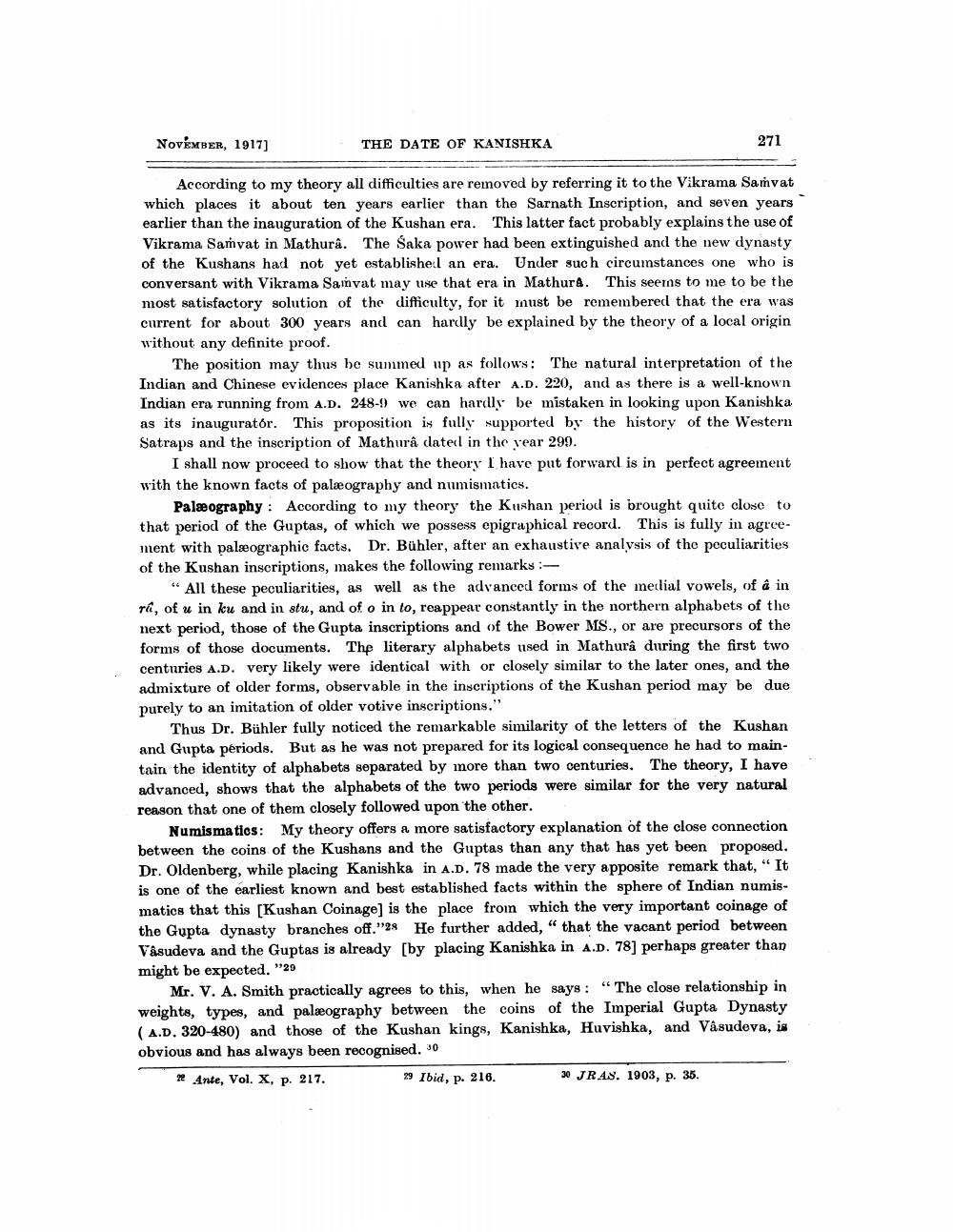________________
NOVEMBER, 1917)
THE DATE OF KANISHKA
271
According to my theory all difficulties are removed by referring it to the Vikrama Samvat which places it about ten years earlier than the Sarnath Inscription, and seven years earlier than the inauguration of the Kushan era. This latter fact probably explains the use of Vikrama Samyat in Mathurâ. The Saka power had been extinguished and the new dynasty of the Kushans had not yet established an era. Under such circumstances one who is conversant with Vikrama Samyat may use that era in Mathura. This seerns to me to be the most satisfactory solution of the difficulty, for it must be remembered that the era was current for about 300 years and can hardly be explained by the theory of a local origin without any definite proof.
The position may thus be summed up as follows: The natural interpretation of the Indian and Chinese evidences place Kanishka after A.D. 220, and as there is a well-known Indian era running from A.D. 248-9 we can hardly be mistaken in looking upon Kanishka as its inaugurator. This proposition is fully supported by the history of the Western Satraps and the inscription of Mathurâ dated in the year 299.
I shall now proceed to show that the theory I have put forward is in perfect agreement with the known facts of palæography and numismatics.
Palæography: According to my theory the Kushan period is brought quite close to that period of the Guptas, of which we possess epigraphical record. This is fully in agreement with paleographic facts. Dr. Bühler, after an exhaustive analysis of the peculiarities of the Kushan inscriptions, makes the following remarks :
"All these peculiarities, as well as the advanced forms of the meclial vowels, of â in ra, of u in ku and in stu, and of o in to, reappear constantly in the northern alphabets of the next period, those of the Gupta inscriptions and of the Bower MS., or are precursors of the forms of those documents. The literary alphabets used in Mathurâ during the first two centuries A.D. very likely were identical with or closely similar to the later ones, and the admixture of older forms, observable in the inscriptions of the Kushan period may be due purely to an imitation of older votive inscriptions."
Thus Dr. Bühler fully noticed the remarkable similarity of the letters of the Kushan and Gupta periods. But as he was not prepared for its logical consequence he had to maintain the identity of alphabets separated by more than two centuries. The theory, I have advanced, shows that the alphabets of the two periods were similar for the very natural reason that one of them closely followed upon the other.
Numismatics: My theory offers a more satisfactory explanation of the close connection between the coins of the Kushans and the Guptas than any that has yet been proposed. Dr. Oldenberg, while placing Kanishka in A.D. 78 made the very apposite remark that, "It is one of the earliest known and best established facts within the sphere of Indian numismatics that this [Kushan Coinage] is the place from which the very important coinage of the Gupta dynasty branches off.”28 He further added, " that the vacant period between Vasudeva and the Guptas is already [by placing Kanishka in A.D. 78) perhaps greater than might be expected. "29
Mr. V. A. Smith practically agrees to this, when he says: "The close relationship in weights, types, and palæography between the coins of the Imperial Gupta Dynasty (A.D. 320-480) and those of the Kushan kings, Kanishka, Huvishka, and Vasudeva, is obvious and has always been recognised. Jo + Ante, Vol. X, p. 217.
29 Ibid, p. 216.
30 JR.AS. 1903, p. 35.




